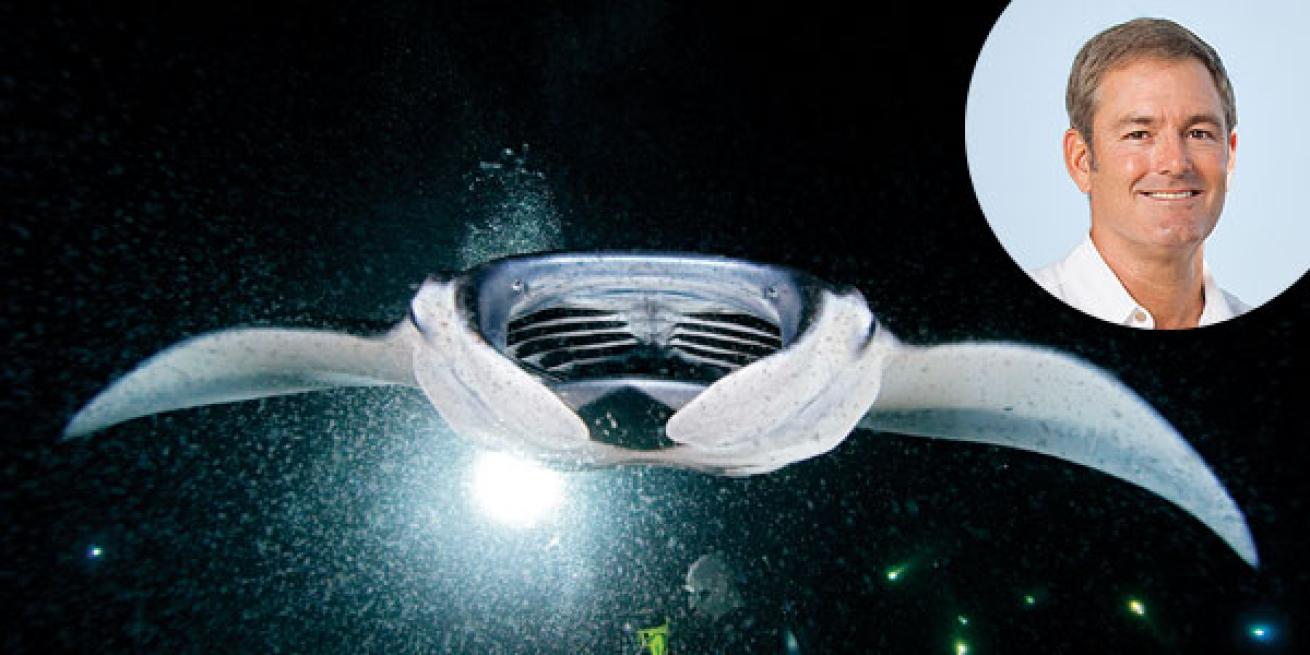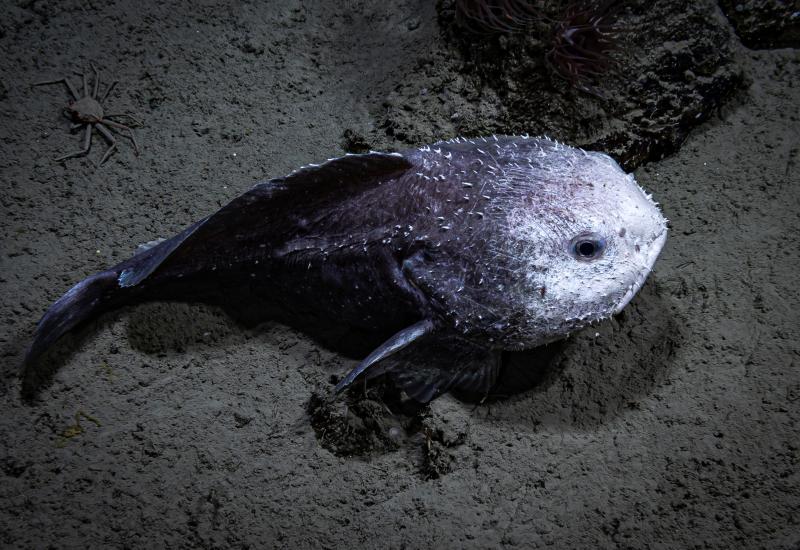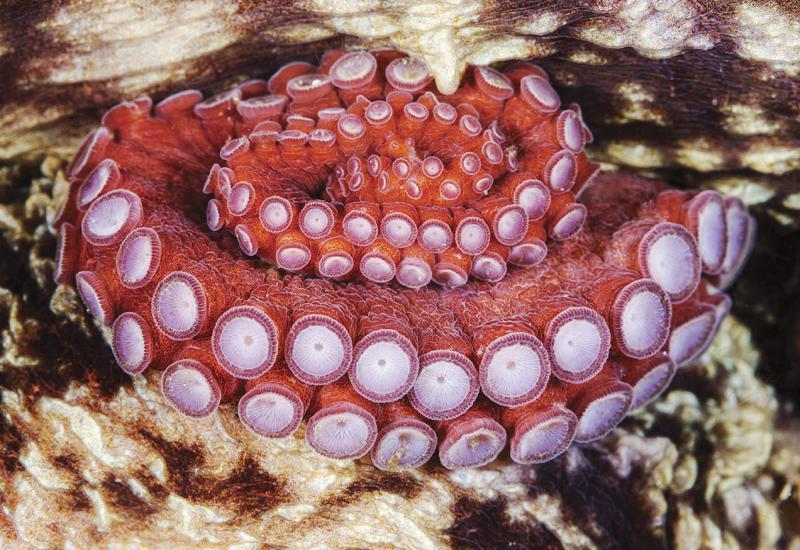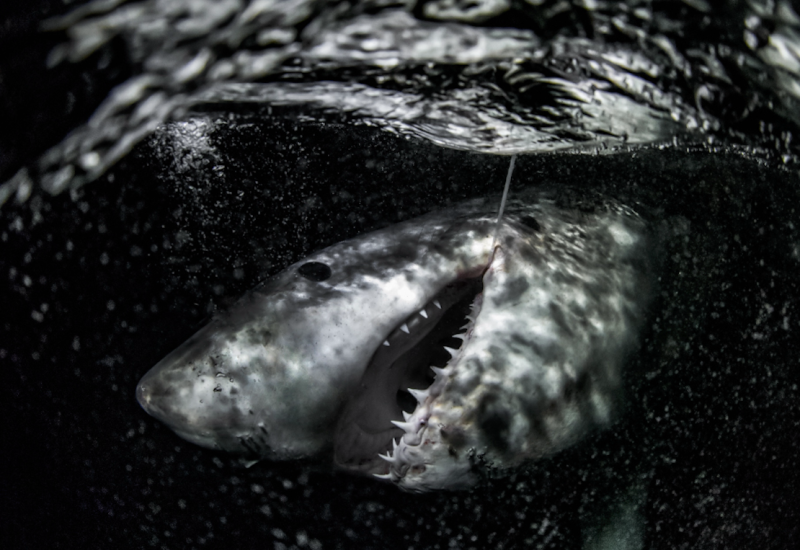Keller Laros Awarded for Saving Manta Rays in Hawaii

Courtesy of Keller Laros; Masha Ushioda/CoolwaterphotoScuba Diving July 2014 Sea Hero: Keller Laros
Video of Keller Laros’ rescue of an entangled Kona dolphin went viral last year, with more than 9 million views. But protecting Hawaii’s manta rays through research, education and conservation is our July Sea Hero’s real focus.
How did you first get involved with mantas?
At Lewis and Clark College, I studied Political Science and History with the intention of eventually going to law school. While there, I became a certified scuba diver to participate in a marine biology field study course in the Caribbean. In 1985, I joined my family on a scuba dive at night with Jack’s Diving Locker in Kona on the Big Island of Hawaii where I saw my first manta rays. This experience blew my mind! After that, it was all over — the course of my life changed!
Later in 1985, I became a PADI Scuba Instructor and by 1991 moved to Kona to work full time at Jack’s Diving Locker. That year, I started leading manta ray night dives. This allowed me to dive regularly with the mantas. I was thrilled! At that time, the manta ray dive was a novelty. I enjoyed taking photographs of the mantas and I noticed that each manta possessed a unique spot pattern on its abdomen and, like fingerprints, could be used to identify individuals. In 1991, I began naming and cataloging the manta ray population in Kona. The first manta ray that I identified was Lefty. She is an adult female approximately 12 feet across and has a broken left cephalic fin. She is still showing up regularly on manta night dives. We now have over 211 Kona manta rays in our Manta Identification Project with Manta Pacific Research Foundation.
What has been the biggest challenge you have faced since founding the Manta Pacific Research Foundation?
Manta Pacific Research Foundation was established in 2002 by a dedicated group of volunteers. We are fueled by the love that we feel for these incredible animals and the promise of making a difference in the world. The biggest challenge for us is always wanting to do more and realizing the constraints of reality. We have an incredibly committed group of individuals that give so much, but it’s time for our organization to go to the next level and to do that we need more support. We have some very exciting projects that will help manta rays now and in the future.
What's been your most rewarding moment working for manta ray protection?
The short answer would be on June 5, 2009 when Governor Linda Lingle signed Act 092(09) making it illegal to kill or capture mantas rays in Hawaii. This concluded the campaign that Manta Pacific Research Foundation began in 2003.
The long answer would start in1991 when the manta ray night dive began gaining momentum. At first, only one boat with up to six to eight divers went to the manta site only a few days a week. By 1993, it had grown to as many as five boats and up to 50 people in the water. We thought it was pretty chaotic and decided some sort of standard was needed to increase safety and create a sustainable experience. A group of local scuba dive operators got together to talk about how to conduct manta ray night dives. I was one of these concerned individuals and together we created the guidelines for the manta ray encounter. The goal was to provide a safe experience for divers and manta rays.
Quickly stated the guidelines are:
Observe only — Don’t touch the manta rays!
Divers stay on the bottom.
Snorkelers stay on the top.
Divers shine lights up. Snorkelers shine lights down.
Divers time your breathing so you don’t blow bubbles into the manta’s face.
If taking photos or video, keep gear away from the manta rays.
The guidelines were initially printed and distributed with the help of The Ocean Recreation Council of Hawaii and PADI Project AWARE but that was long ago. For several years now, Manta Pacific Research Foundation supplies these guidelines both online and in print. These guidelines are a standard in the manta tour industry in Kona and the result is that mantas are treated with respect and will approach humans closely. I attribute the success of the Kona Manta Ray Night Dive to these guidelines.
After about a decade of doing the manta dive, it was time for protection. In 2002, we learned that a growing demand for dried manta gills in Asian markets had led to manta rays being fished aggressively throughout the Pacific. Fearful that the Kona manta population had no protection, Manta Pacific Research Foundation embarked on a journey to protect the rays in Hawaii. By 2003, there were thousands of tourists diving and snorkeling with manta rays in Hawaii annually and there were about a dozen charter operators that conducted the dive. The increasing numbers of manta tour participants created our base of support when the time came to get manta rays protected in Hawaii. It seemed it was in everyone’s best interest to protect the manta rays.
In 2003, we received the endorsement of the West Hawaii Fisheries Council to protect manta rays. Unfortunately the monetary penalties that the Council could assess were insignificant and wouldn’t serve to deter people from fishing for mantas. We spent the next couple of years planning our strategy to determine the best method of getting mantas protected. We explored administrative rules that the State Department of Land and Natural Resources (DLNR) could enact. However we found little interest or support from DLNR.
In 2005, one of our local State legislators introduced House Bill 960 that would protect manta rays. It wasn’t even heard in committee. The powers in Honolulu weren’t concerned. This was frustrating because we felt that the Kona mantas were vulnerable to being killed because of the increasing demand for manta parts in Asia. Additionally, mantas rays had become extremely important to commercial tourism, the number one industry in Hawaii. Most importantly manta rays are such rare and unique creatures we felt very strongly that they should be protected for purely existential reasons.
In 2006, we again attempted to have manta rays protected through legislative action. This time we had local television news personalities snorkel with manta rays and they became instant advocates. They broadcasted the story on local news programs and this helped to raise awareness. We also gathered more then 5,600 signatures on a petition in support for manta ray protection. We had people write testimony and children submit letters and pictures. In 2006, House Bill 960 to protect manta rays was reintroduced with a broader base of support. During the resulting committee hearings a university marine biology professor and the Department of Land and Natural were opposed to the bill. The Chairman of the DNLR told the committee that his office already had the power to protect manta rays and gave the impression that they worked for the governor and not the legislature. The Chairman of the legislative committee pointed out that they approved funding for the budgets of state agencies; a tense moment was defused when the committee passed House Resolution 30 that directed the Department of Land and Natural Resources to study manta rays and create a management plan. Failing that, it was incumbent on the legislature to take action.
Throughout 2006, 2007 and 2008, the Scientific Advisor of Manta Pacific Research Foundation repeatedly reached out to the Division of Aquatic Resources of the Department of Land and Natural Resources in an attempt to fulfill House Resolution 30. We had no success and as far as we know, no progress was made by the State of Hawaii DLNR to comply with the resolution.
In 2009, we went back to our local representatives about manta protection in the State of Hawaii. They introduced legislation concurrently in the Hawaii House of Representatives with House Bill 366 and the Hawaii Senate with Senate Bill 394. This time, the bills were widely supported. On June 5, 2009, the Governor of the State of Hawaii signed Act 092(09) making it illegal to kill or capture manta rays in Hawaii! Penalties included up to a $10,000 fine and forfeiture of any manta rays, commercial marine license, vessel, and fishing equipment. This was an extremely rewarding moment for me, Manta Pacific Research Foundation, all who participate in manta tours, and manta enthusiasts everywhere.
How can everyday divers and Scuba Diving's readers help further the work of Manta Pacific Research Foundation?
Everyday divers and Scuba Diving’s readers can help further the work of Manta Pacific Research Foundation by participating in the Manta Identification Project by submitting images of mantas to add to the database. The images need to show the abdominal spots and coloration so that we can accurately identify the manta ray. We also need the date, location, and estimate of size. If it’s a new manta, the person that submits the photo has naming rights. That’s always fun. We currently have 211 manta rays in our catalog.
If you don’t have the opportunity to take a photo of a manta ray, we encourage manta enthusiasts to give a tax-deductible donation to the Manta Identification project or one of our other projects or education programs.
What's next for Keller Laros and Manta Pacific Research Foundation?
As a professional dive guide with Jack’s Diving Locker, I have a unique opportunity to dive with manta rays several times per week and have done this every year since 1991. My plan for the future with Manta Pacific Research Foundation is to continue to identify mantas rays and document their activity. I do this with video and photo equipment and have a vast library of documented activity from mantas in the wild. In addition, the identification catalog of Manta Pacific Research Foundation is one of our most important assets. This documentation is key in manta conservation efforts. Showing a documented residential population of manta rays was important when working on manta protection in the State of Hawaii. This is even more important as we work toward national protection in the United States.
Dr. Eli Michael is back collecting more data for our measurement and growth study. He took baseline measurements in 2009. His plan is to take new measurements now and compare differences. Manta Pacific Research Foundation has a specialized apparatus with laser beams and mounted camera for this work.
Another project we are working on is with manta researcher, Dr. Csilla Ari and it’s called Manta Memories. The goal is to help people in manta ray fishing villages in other parts of the world support themselves with alternative options instead of manta ray fishing and trade.
We are also developing new and exciting online educational resources about manta rays to reach a broader audience. Wendy Laros, co-founder of Manta Pacific Research Foundation, is developing content with the help of the College of Education, University of Hawaii, Manoa.
I am also working with State officials as new developments unfold with manta site management in Kona, Hawaii. It’s now common to see up to 20 boats per night at the dive sites with as many as 200 people in the water at a time. Again this year, a resolution has passed urging DLNR to adopt rules to better manage manta dive sites to ensure safety and order is maintained. I facilitated a working group for new operator standards last year, so we feel we can help the State agency get the job done.
At Manta Pacific Research Foundation, we are also developing the Manta Rescue Project. Entanglement from fishing gear is a real problem for manta rays that can be life threatening. I’m working on rescue guidelines that will help other manta guides know what to do when encountering a manta ray with fishing line or hooks. I’ve had a number of opportunities to remove line and hooks from mantas, sea turtles, and even a bottlenose dolphin! Last year, a wild bottlenose dolphin actually swam through the manta night dive site and kept circling divers. Finally, it let out a loud squeak as though it were calling for help. I looked and saw fishing line wrapped around its left pectoral fin and running into its mouth. I gestured to the animal to come with my index finger and it did! I then proceeded to remove the fishing line and hook. This took several minutes and the dolphin actually went up for a breath of air and then came back down to complete the process. I used a tool that is a combination knife and scissors and it worked well to cut the line. I always carry this tool with me because I’ve used it many times with other rescues. If the fishing line is not removed it typically tightens around the animal and actually cuts through them. We often see manta rays with missing cephalic (head) fins due to fishing line injuries. I didn’t want the dolphin to lose its pectoral fin because of fishing line. That kind of injury could make the difference in the animal’s ability to survive. My goal with the Manta Rescue Project is to share my knowledge and experience in rescuing animals to increase the help we can give to these animals.
What would you do with the $5,000 cash award if selected for Sea Hero of the Year?
I will donate the money to Manta Pacific Research Foundation to enhance the Manta Identification Project. We want to invest in a state-of-the-art computer program to organize our data more effectively as well as invest in new camera equipment to capture the images we need. We have collected data of individual residential manta rays on the Kona coast that dates back to 1991 and we don’t want to stop now. As mentioned, documenting the manta rays is key to manta conservation. We used this information when working toward protection in the State of Hawaii and we will use it again as we work toward National protection.
Is there anything we did not ask that you would like readers to know?
I feel extremely fortunate to have the opportunity to be in the ocean with manta rays several nights per week year after year. The grace and beauty of these gentle giants is captivating, but there’s more. Manta rays have a sense of their surroundings and an innate intelligence that is remarkable. They are charismatic creatures that evoke awe in all of us. My goal is to continue to combine passion with purpose and dedicate my life to research, education, and conservation concerning manta rays and their marine environment.
Manta Pacific Research Foundation was established in 2002 and is a 501(c)(3) non-profit organization with a mission is to study manta rays in their natural habitat, conduct scientific research, provide education programs for the public about manta rays and the marine environment, and to establish and promote global manta ray conservation. Support manta rays by giving a tax-deductible donation to Manta Pacific Research Foundation.
More Sea Heroes:
Gwyn Mills | Troy Bodden | Jessica Cramp | Sea Hero Nominations
Learn more about Sea Heroes and view all past recipients of the award.










